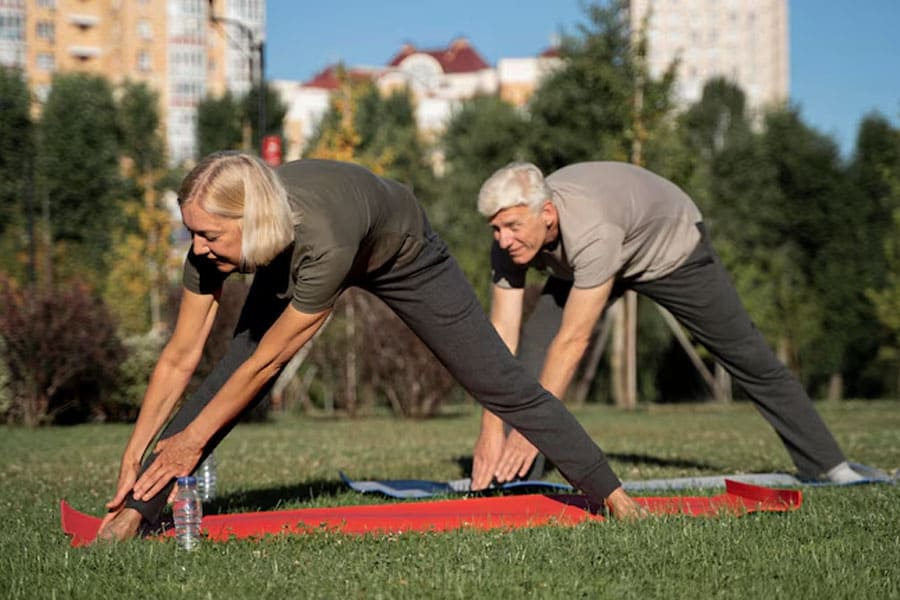
Joint gymnastics for the elderly
The physiology of the human body is such that with age, the nutrition of organs and tissues gradually deteriorates, leading to a noticeable decrease in functionality. The musculoskeletal system is also not spared by such changes, as is eloquently evidenced by the high incidence statistics. Arthritis and arthrosis of various localizations bring a lot of suffering to older people, however, it is in our hands to correct this situation. An excellent means of prevention is joint gymnastics for the elderly after 60 years, which helps to prolong active longevity.
What results can be obtained from a set of joint exercises?
Over the years, cartilage tissue and ligaments lose their elasticity, limiting the range of motion in the joints. Against the background of pain, a person instinctively begins to reduce his motor activity, thereby starting a vicious circle – physical inactivity, dystrophy, pain. To prevent this from happening, you need to take preventive measures in time that can slow down age-related changes.
The most effective methods of prevention include a special set of joint exercises for the elderly. The effectiveness of regular exercise is as follows:
- Improvement of blood and lymph microcirculation;
- Normalization of metabolic processes;
- Increase in the production of synovial fluid;
- Restoration of muscle and bone tissue;
- Expanding the range of motion in the joints.
In addition, joint gymnastics for the elderly after 60 years reduces the risk of developing many other diseases associated with physical inactivity and improves overall well-being. Feeling flexible, energetic and active again – isn’t this what every sane person strives for?
Effective exercises for different groups of joints
Before performing a set of physical exercises, it is necessary to do a short warm-up, carefully moving and rotating the feet, knees, elbows, neck, spine. All movements, given the age, should be extremely smooth and not tense, aimed only at warming up the tissues and increasing blood flow. After this, you can move on to the gymnastics itself.
- Head tilts – smoothly tilt the head to the sides and down, but avoid moving it backwards. Repeat 5-7 times, depending on the capabilities of the body.
- Rotation of the shoulder joints 4 times forward and backward – perform 5-7 approaches.
- Bringing and spreading the knee joints – from a half-squat position, bring the knees together and spread them apart, trying to keep your back straight. Perform 3 repetitions of 4 times.
- Squeezing the hands – stretch your arms forward, clench them into fists, then relax. Do 3 repetitions of 8 squeezes, gradually increasing the frequency and intensity.
- Rotating the feet – from a sitting position, stretch your legs forward and pull your toes towards you with force, then make circular rotational movements with your feet 6-8 times in both directions.
- Lunges with squats – from a standing position, step forward with one leg and bend it at the knee. At this time, the other leg is stretched back with support on the floor. On the count of two, do a simple turn, changing the position of your legs. This exercise should be done 6-8 times, leaning on the back of a chair to maintain balance.
As for the time of the classes, it is traditionally believed that the morning complex is more effective, as it allows you to recharge with energy for the entire next day. However, if it is not possible to do gymnastics in the morning, then you can practice it at a convenient time for yourself.

General recommendations for performing a set of exercises
Considering the fact that joint gymnastics for the elderly is intended for older people, when performing it, you should follow a number of recommendations. Let’s start with the fact that you cannot start physical exercise during an exacerbation of diseases of the musculoskeletal system. During a period of stable remission, you can practice exercises almost every day, not forgetting to monitor your own health.
Before the main part of the complex, you should definitely do a warm-up to properly prepare the body.
The duration of one session is on average 30 minutes, adjusted for health and age. If doing half an hour a day is too tiring, then you can reduce the time to 20 or even 15 minutes. As your health improves, you need to gradually increase the duration of the gymnastics.
